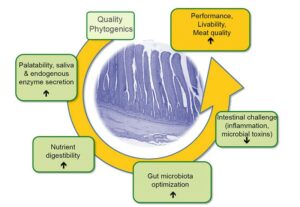THE IMPORTANCE OF MAINTENANCE NUTRIENT REQUIREMENTS DURING PERIODS OF HIGH FEED PRICES
Author: Dr Neil Gannon, Regional Product Manager – Gut Performance, BIOMIN Asia-Pacific
Animal production around the globe is continually subjected to challenges around sourcing feed ingredients at the right price, and/or of the desired quality and/or with consistent supply. If periods of high feed ingredient prices also occur at the same time as depressed meat prices, as is currently seen in many parts of the world, the animal producer is placed under considerable financial stress.
Because feed is the most significant contributor to the costs of production, many strategies are set in place to optimize feed costs and feed conversion when profits are low. Sometimes the strategies employed in pork production are to decrease nutrient density (‘cheapen up the feed’ through use of less energy or nutrient dense raw materials such as by-products) and/or reduce feed intake. On the surface this may appear to be a cost effective strategy for saving on feed costs (and in certain circumstances is the best approach) but the strategy ignores the importance of ‘maintenance nutrient requirements’. This article discusses the importance of the contribution of ‘maintenance’ to overall feed efficiency and why maximizing, not restricting, swine feed intake and growth rates should be considered as an economic strategy when feed prices are high.
In simple terms, animals need (require) nutrients such as carbohydrates, fats, amino acids, water, vitamins and minerals for two purposes – either ‘maintenance’ or ‘production’. Maintenance nutrient requirement refers to the quantity of nutrients to keep the animal alive in a thermo-neutral environment (that is, their ideal comfort zone where they are not too hot or too cold) at ‘steady state’ such that the animal is neither gaining nor losing body weight. Maintenance requirements incorporate all of the nutrient needs for vital activities such as breathing, blood circulation, normal kidney, brain and cell functioning but with no real allowance for physical activity. Nutrients required for ‘Production’ relate to all the nutrient needs associated with growth, gestation or lactation, depending on the stage of life of the animal. When an animal consumes feed, the nutrients in the feed have to be utilized first for maintenance purposes and any surplus can then be used for productive purposes. From this brief explanation of nutrient utilization it is hopefully clear that many situations such as stress, disease (and the subsequent immune responses), hot or cold environments, increased activity such as walking to the feeder or fighting, will increase the quantity of nutrients needed to keep the animal alive and therefore decrease the quantity of nutrients available for production.
As knowledge of the maintenance nutrient requirements is critical to determining the effective feeding programs of livestock, many research organizations using sophisticated techniques have developed algorithms for calculating maintenance energy and amino needs for animals of different weights and stages of production. These algorithms can be readily found in the scientific literature. For the purpose of the current discussion and in an attempt to summarize a large body of work into some simple statements, a typical estimate for the maintenance energy needs of growing pigs under normal commercial conditions is approximately 25% of the metabolizable energy intake (or 20% of total energy intake). Figure 1 shows the energy utilization of growing pigs fed corn – soybean meal- based feeds (adapted from Kil et al 2013).
Figure 1. Energy partitioning in growing pigs consuming corn and soybean meal based feeds
As the requirement for amino acids for protein deposition (muscle) in the growing pig is quite dominant, the maintenance requirement for lysine and other amino acids is fortunately quite small and in the range of 3-10% of the individual digestible amino acid intake.
Why is all this relevant when feed prices are high? Hopefully the answer can be seen when we look at the typical feed intake of a finisher pig with a liveweight of about 100 kg. Although the absolute number will vary depending on breed, housing and feed ingredients etc, a 100 kg finisher pig would be expected to eat about 2.5 kg of feed per day. If we assume from the discussion above that approximately 20% of the energy in this feed is needed for maintenance, this means 0.20 x 2.5 kg or 500g of feed per day is required for maintenance and leaves 2500-500=2000g of feed available for production. If the pig is growing at a typical growth rate of modern genotypes of 1000 g/day, the effective feed conversion ratio for the productive component of the feed is 2000g/1000g or 2.0. If the same 100 kg pig has a ‘restriction’ put on the amount of feed pig it can consume through physical feed reduction and/or offered rations that are less energy dense through the use of by-products, the pig may now be only consuming the equivalent of 2.0 kg per day. The maintenance energy requirement of the pig does not change and this component is still about 500 g which means there is now only 2000-500 g=1500g of feed available for growth. Assuming the same productive feed efficiency of 2.0 is possible, the pig can now only grow at 750 g/day (250 g less or a 25% reduction compared to the full fed pig).
After a week on his regimen, the finisher pig would be estimated to be 1.75 kg lighter in weight. The price of feed and the price of pig meat varies widely around Asia but it is possible to calculate what the expected impact of reducing the nutrient density or feed intake of the finisher pig would have on profitability in a particular country. By way of example, assuming finisher feed costs US$500 per tonne, and a low pork meat price of US$1.75 per kg, feed savings would need to be approximately US$50 per tonne of feed to offset the slower growth rate from reducing the density or feed intake.
The ‘hypothetical’ analysis above makes some assumptions and generalisations that can be discussed further and fine-tuned, but hopefully serves to illustrate the importance of considering maintenance requirements in livestock production. In addition to the nutrients required to keep the animal alive and functioning, there are considerable nutrient needs that are not considered in the above analysis of maintenance resulting from significant factors such as disease, coping with temperature and humidity effects and many other stressors that occur in animal production. These factors are well known to rob the animal of nutrients and further reduce growth, lactation and gestation performance and ultimately profitability and are worthy of mitigation.
More recently, as animal protein producers strive to reduce the reliance on antibiotics, there has been a greater understanding of the role that gut inflammation processes play in consuming nutrients that otherwise could be used for productive purposes. Quality phytogenic feed additives such as Digestarom® from BIOMIN have been shown to significantly reduce the over-stimulation of the immune system. The essential oil components in Digestarom® have also been proven to assist with maximising feed intake, stimulation of digestive enzymes to improve nutrient availability and positively modulating the gut microbiota. Figure 2 shows the combined effects of Digestarom® and how the use of phytogenic feed additives can lead to improvements in animal performance.
Figure 2. Mode of action of quality phytogenics
In conclusion, this article has hopefully identified the importance of the nutrient requirements for maintenance and how an increase in maintenance requirements or un-productive processes can significantly limit the performance potential of animals. In situations of high feed prices, and subject to other valid financial considerations, it is proposed that maximising feed intake and diet density to get animals to slaughter as quick as possible may be a strategy worthy of consideration to optimise profitability. The use of quality phytogenic feed additives such as Digestarom® from BIOMIN may also assist in optimising the efficiency of use of nutrients for productive purposes during periods of high feed prices.





